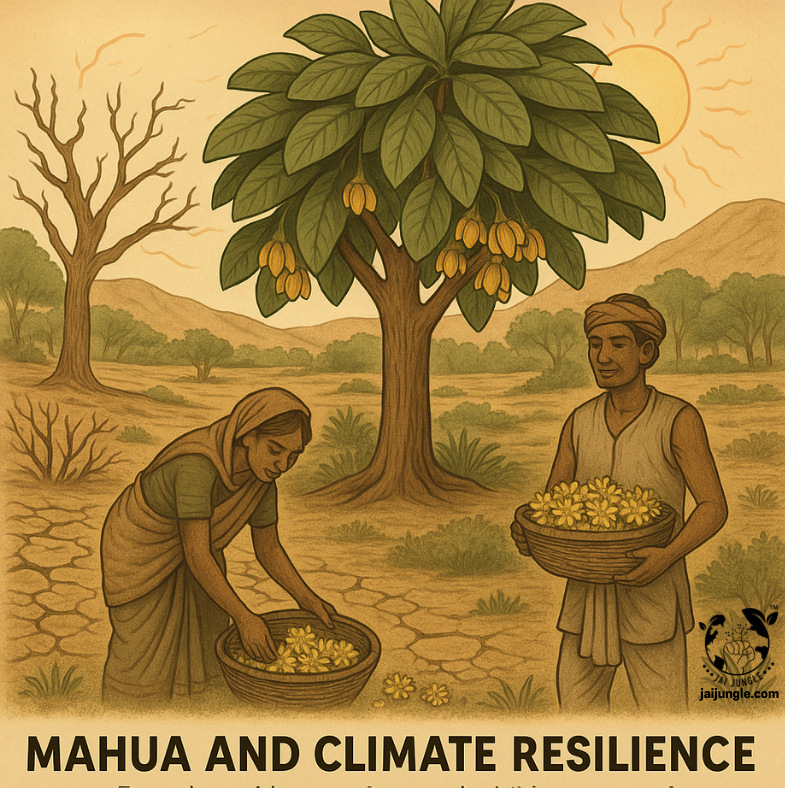Why Mahua Matters in a Changing Climate
As climate change reshapes rainfall patterns and raises temperatures, rural India increasingly depends on hardy, climate-resilient species. Mahua (Madhuca longifolia)—a native tree of India’s dry tropical forests—stands out for its remarkable ability to survive extremes and sustain local livelihoods.
Unlike annual crops that fail under drought or heat stress, Mahua continues to flower, fruit, and provide food, fodder, and income. For many forest-fringe communities, “Mahua nahin sukhta” (Mahua doesn’t dry out) has become both proverb and proof of resilience.
Drought Tolerance and Water Resilience
Mahua is naturally adapted to semi-arid and tropical climates, thriving with as little as ~550 mm of annual rainfall (Dubey et al., Phcog Rev, 2019).
Its deep taproot system penetrates several meters below the surface to access subsoil moisture and groundwater, allowing it to stay green and productive even during long dry spells.
- Livelihood buffer: In years of crop failure, Mahua flowers and seeds still yield usable harvests, providing food or income insurance.
- Soil moisture retention: Leaf litter enriches organic matter, improving infiltration and reducing surface runoff.
- Groundwater recharge: Dense Mahua stands encourage percolation; anecdotal evidence shows improved water tables in such micro-ecosystems.
These features make Mahua ideal for ecosystem-based adaptation, where vegetation improves local hydrology and microclimate stability (Phcog Rev 2019).
Heat Resilience and Microclimate Cooling
Mahua tolerates temperatures up to 45–46 °C (Phcog Rev 2019) without major physiological stress.
Its broad, dense crown acts as a natural shade canopy, offering measurable cooling benefits:
- Reduces under-canopy temperature by 2–4 °C in hot months.
- Protects understory crops and livestock from heat stress.
- Mitigates heat-island effects in rural settlements.
When planted in agroforestry rows, Mahua moderates sunlight intensity, helping maintain soil moisture and crop yields even in extreme summers.
Carbon Storage and Climate Mitigation
Beyond adaptation, Mahua contributes to climate mitigation through long-term carbon sequestration.
Studies from ARCC Journals (2022) and Indian Journal of Plant and Environment (2021) show:
| Parameter | Average Value | Source |
|---|---|---|
| Carbon storage per mature tree | 250–450 kg C | ARCC Journals 2022 |
| Annual CO₂ absorption | 20–25 kg CO₂ eq / tree | IJ Plant & Environment 2021 |
| Lifespan | 80–100 years | Field observations |
If incorporated into community forests and farm boundaries, Mahua can significantly increase the carbon stock density of dryland landscapes.
When its dense wood is used in furniture or rural construction, the sequestered carbon remains locked for decades, replacing emission-intensive materials like cement or steel.
Storm and Flood Resilience
Mahua’s deep anchoring roots provide mechanical stability to soil, preventing erosion and slope failure during intense rains.
Although it prefers well-drained soils, Mahua often coexists with other sturdy species in mixed forests that act as natural windbreaks.
Post-storm observations (ARCC 2021) show that Mahua trees often defoliate but regenerate rapidly, while brittle species break.
However, extended waterlogging can still harm root respiration—an emerging concern as extreme rainfall events increase under climate change.
Food and Nutritional Security Under Climate Stress
Mahua serves as a food-security buffer in uncertain seasons:
- Flowers – Dried or fermented for energy-rich foods and drinks during lean periods.
- Seed oil – Substitute cooking medium when commercial oils become costly or scarce.
- Leaves & fruits – Fodder for cattle when pasture grasses fail.
By supporting livestock survival, Mahua indirectly sustains milk supply and household nutrition.
This diversification of edible and tradable outputs makes it a climate-adaptive food system rather than a single-product crop.
(References: 101Reporters 2023; Roat 2023, ResearchGate)
Cultural and Psychosocial Resilience
Mahua’s role goes beyond ecology and economics.
Its flowers and festivals—such as Mahua Parva in tribal communities—strengthen cultural identity and social cohesion.
During crises, collective harvesting, drying, or brewing of Mahua reinforces community networks and morale.
Such cultural ecosystem services contribute to psychosocial resilience, enabling communities to adapt collectively to stress.
Diversified Livelihoods as Adaptation
Mahua offers multiple value chains—flowers, fruits, seed oil, herbal teas, jams, fermented tonics, and bio-fertilizer seed cake.
This product diversity spreads risk: when one yield fails due to climatic anomaly, others sustain incomes.
It embodies the principle of livelihood diversification, key to adaptive capacity in climate-vulnerable regions.
Mahua in Climate Policy and Adaptation Programs
National and state initiatives increasingly recognize Mahua’s potential for climate-proofing rural landscapes:
- CAMPA Afforestation: Mahua planted on degraded forest land for both carbon sequestration and community resource enhancement.
- Climate-Smart Villages Initiatives (ICAR & NGOs): Promote Mahua along farm peripheries for shade, fodder, and biodiversity.
- Sub-Mission on Agroforestry (SMAF): Lists Mahua as a preferred NTFP tree for dryland agroforestry models.
By combining mitigation and adaptation, these initiatives turn Mahua into a flagship species for ecosystem-based adaptation (EbA) in central and eastern India.
Climate Threats to Mahua and the Need for Conservation
Despite its resilience, Mahua faces climate-related challenges:
- Unseasonal rains during flowering (Feb–Apr) can cause flower drop.
- Warmer winters may alter flowering triggers.
- Prolonged flooding damages root systems.
Yet, Mahua’s wide climatic tolerance—from 2 °C to 46 °C and from 550 mm to 1,200 mm rainfall—(Phcog Rev 2019) ensures it will outcompete less adaptive species.
Conserving diverse genetic provenances will further safeguard its future adaptability.
Integrating Mahua into Resilient Landscapes
By linking ecological stability with human well-being, Mahua demonstrates how biodiversity and traditional knowledge can drive resilience.
It provides:
| Climate Function | Mahua’s Contribution |
|---|---|
| Adaptation | Drought, heat, and livelihood buffering |
| Mitigation | Long-term carbon storage |
| Ecosystem service | Soil fertility and water regulation |
| Socio-cultural | Community identity and cohesion |
“Mahua doesn’t just survive climate change—it helps people survive it.”
Conclusion
From drought tolerance to food security, Mahua stands as a keystone of climate resilience in India’s forest-farm interface.
Its ecological durability, cultural continuity, and economic versatility make it indispensable in building sustainable, climate-smart rural systems.
Incorporating Mahua into national adaptation strategies exemplifies working with nature to adapt to climate change, harnessing both science and traditional wisdom for a resilient future.
References and Data Sources
- Dubey et al. (2019). Pharmacognosy Reviews. “Adaptive Physiology and Climate Tolerance of Madhuca longifolia.” https://phcogrev.com
- ARCC Journals (2022). “Tree Carbon Stock Estimation in Tropical Agroforestry Systems.” https://arccjournals.com
- Indian Journal of Plant and Environment. (2021). “Biomass and Carbon Sequestration Potential of Mahua.” https://ijplantenviro.com
- 101Reporters. (2023). “Forest Economy and Mahua as a Resilience Crop.” https://101reporters.com
- Roat, P. (2023). Socio-Ecological Adaptation in Central Indian Tribal Regions. ResearchGate. https://researchgate.net

